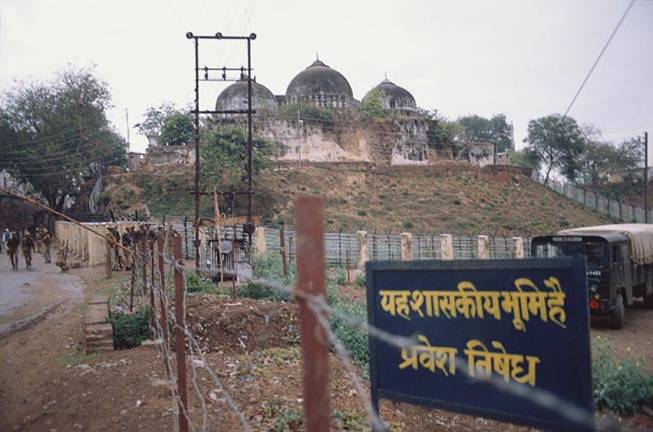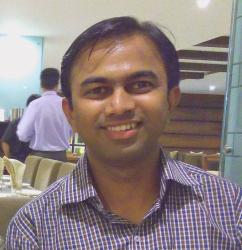The Ram Masjid Center for Religious Harmony

THE TIMES OF UTOPIA
THE RAM MASJID CENTER: A TRIUMPH FOR WORLD PEACE
By Rita Shikhar. DECEMBER 06, 2015. Ayodhya, India.
A true leader, it is said, leads his people to where they should be and not necessarily where they want to be. This day, the 6th of December 2015, will go down in history as one of those days when such leadership was at its most brilliant display. A day when a wise and ancient civilization gave thumping proof of the towering heights of its sagacity. A day when a chaotic nation showed that what one needs for resolving even the most intractable of historical disputes are just some political will, some rationality, and some common sense.
It all began almost a year ago, on the 6th of December 2014, when the Prime Minister of India tweeted: “My government has devised a peaceful solution for the Ayodhya dispute. Will you support us?” (That tweet later went on to become the most re-tweeted in history.) And today, finally, after an initially tense and then exciting wait of nearly a year, that magic solution came to life as Nobel laureates Kailash Vidyarthi and Ghazala Yousuf inaugurated the ‘Ram Masjid Centre for Religious Harmony’ in Ayodhya.
As is almost always the case, the solution for a centuries-old problem turned out to be a profoundly simple one. Hindus and Muslims have both suffered tremendously because of this tussle in the name of Allah and Ram, the PM said, and “we need to take India ahead now.”
What the PM had done was convene a high-level meeting of religious studies scholars and eminent historians (religious ‘leaders’ were kept out). He brainstormed with them to ‘find the most optimal solution to the Ayodhya dispute once and for all’. Everyone concurred that the impasse will continue indefinitely and also cause loss of life and property if either a mandir or a mosque were built. Building both on the same site was also ruled out because they believed that would only act as a ‘BandAid’, with the underlying tensions continuing to simmer. It was concluded that the disputed site best be used for something ‘neutral’ that would help in improving the conditions of the city of Ayodhya and give its citizens a better standard of life. The experts were in favor of building a school or hospital.
What the Prime Minister then added to the suggestions and how he packaged it for the public was pure genius.
In a radio speech last year on 14th December he said, “For the greater good of the people of Ayodhya and of India, I appeal to all parties in the dispute to relinquish their claims on the disputed site. The town of Ayodhya is plagued with problems. Weak health and education systems, law and order deficiencies, weak infrastructure. But here we are, still fighting over a 400-year-old issue.
“My government today pledges to invest in the problem-stricken sectors of the city. Besides, as the most optimal solution for the Ayodhya dispute we propose the construction, on the disputed site, of an international centre for religious studies. The presence of such a high-level educational center will accelerate the growth of the town’s economy.
“The proposed academic center will work to highlight and bring out the positive aspects of all religions and cultures on the planet. Religious intolerance is destroying people and societies in several parts of the world, and we need to study this rising problem seriously and devise peaceful, long-lasting solutions.
“While the West conceived a ‘war on terror’ using the gun, the East will wage its battles, as it has always, by wielding the mind and the intellect; and this centre will be at the forefront of it all. I assure you, people of India, that this will make both Allah and Ram proud, and help re-establish our country’s historical supremacy in matters of the mind.”
And thus was born the Ram Masjid Center for Religious Harmony. Expectedly, both Hindu and Muslim extremists went hammer and tongs against the proposal. But the PM deftly handled all opposition, making it clear that as prime minister he had a duty towards the architects of India’s freedom to assure that the nation stayed inclusive and united. The PM’s strong will was complemented by the numerical strength of India’s millions of peace-loving citizens as they started voicing their approval and satisfaction on social media and on streets. The extremists did try to disrupt order, but perhaps for the first time, the collective voice of the moderate Indian citizens was too loud for them to handle. The legal aspects were taken care of, and the construction of the dream center began.
The international community praised India and its people for the unique and peaceful move, especially when much of the world was (and is) grappling with violent conflicts over religious issues. The Secretary-General of the newly-renamed United States and Nations said, “Finally, we have a good modern example to show how a strong and positive political will can help achieve peace and assure the well-being of citizens. I hope other nations take a leaf out of India’s extraordinary experiment.”
Several European and African governments, convinced that religious harmony and tolerance are the need of the hour, supported India’s initiative by announcing full funding for students desirous of studying at the new center.
There were even unverified reports in the Russian press of their President nominating the Indian PM’s name for the Nobel Peace Prize.
“If the Peace Prize at times has been awarded to Western people who did nothing exactly peaceful, then here we have a truly deserving statesman from the East who has actually done something that can act as a catalyst for lasting world peace.”
Skeptics point out that the differences between India’s Muslims and Hindus are too deep-rooted to go away so easily. But from what this reporter saw in Delhi and Ayodhya over the last two days, the divisive walls are crumbling, especially among India’s vibrant youth.
As one young man put it, “This whole business of violence in the name of religion doesn’t make any sense to me. Religion is so damn accidental! I just happened to be born in my particular religion. That doesn’t mean I have to be aggressive about it or look down upon other religions. There are many more pressing problems in the world. I would rather spend my time thinking about climate change, universal health, sustainable energy, or human rights. And of course sex.”
Perhaps the profoundest assessment was provided by a 91-year old Ayodhya man who has evidently ‘seen it all’.
“I feel happy today. I wanted a total end of the dispute so that intolerant Muslim and Hindu leaders were prevented from regularly inciting communal tension. As long as the matter remained unresolved, it was of benefit to both these self-interested groups, and they were very happy with that despite showing otherwise in public.”
Whether or not Prime Minister Lodi wins the Nobel in future, he now surely joins the ranks of enlightened emperors Ashoka and Akbar (his ancient predecessors), who are revered the world over for their exceptionally inclusive policies which were way ahead of their time.
[Image Attribute: Wikipedia Commons]



